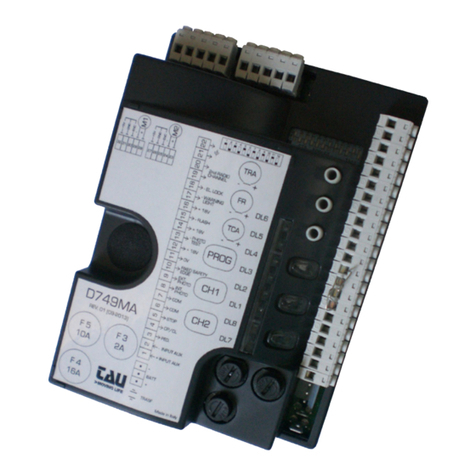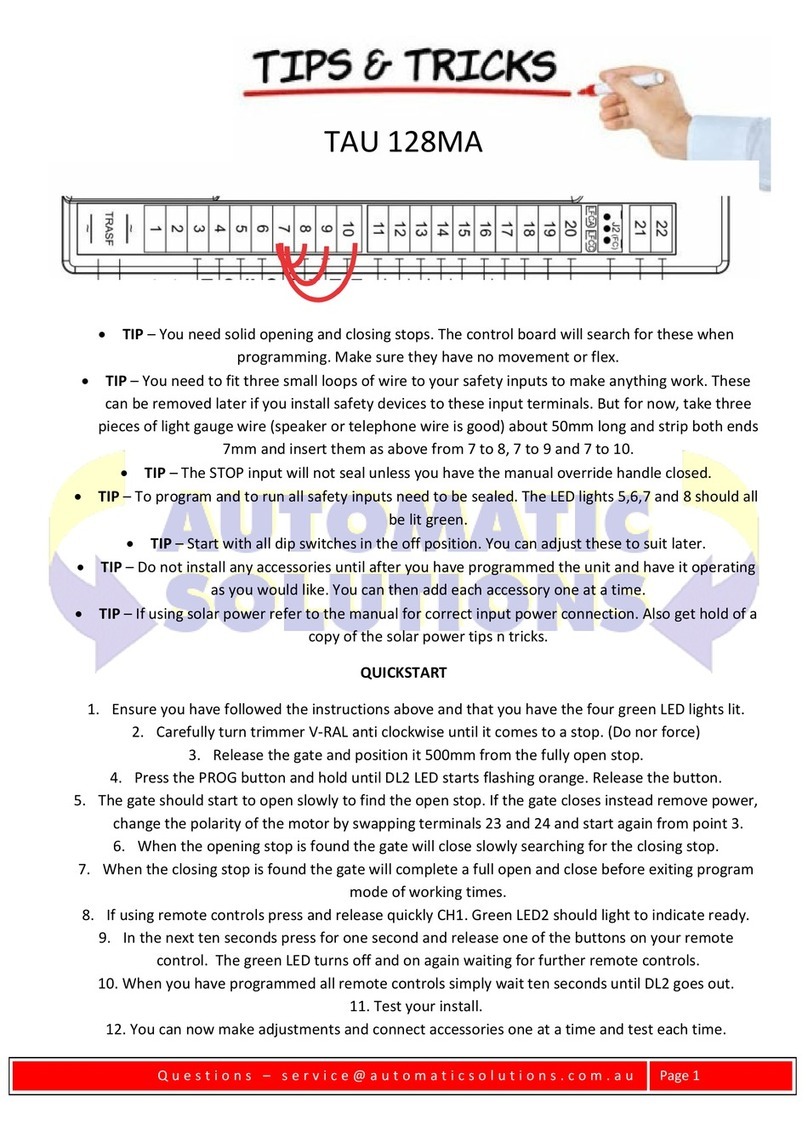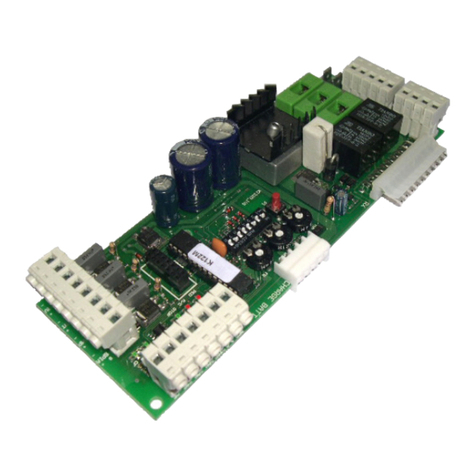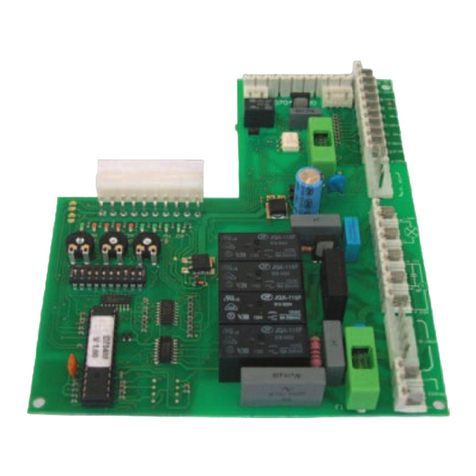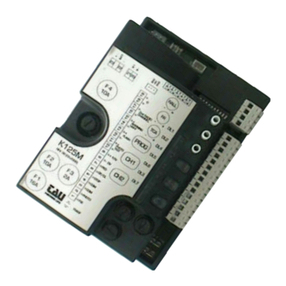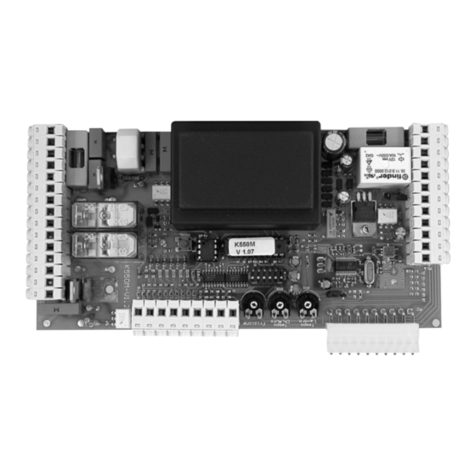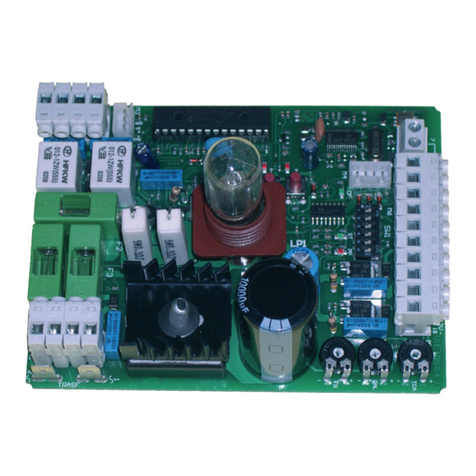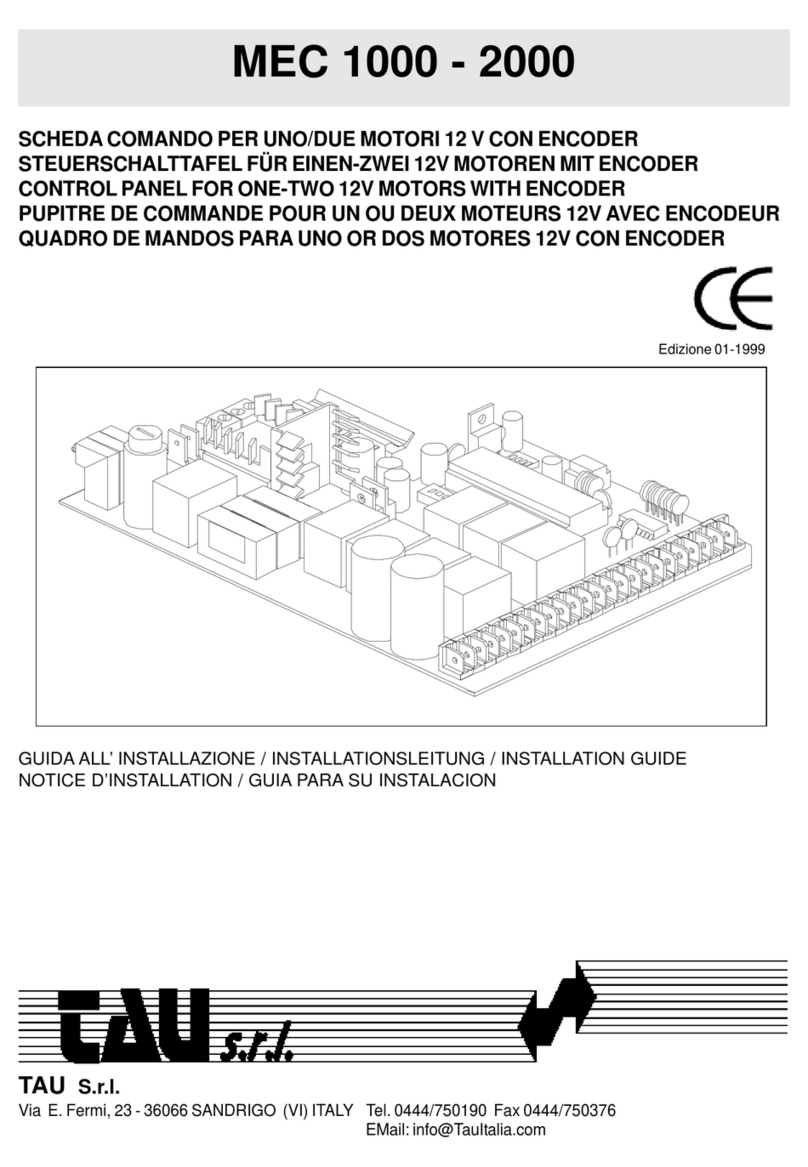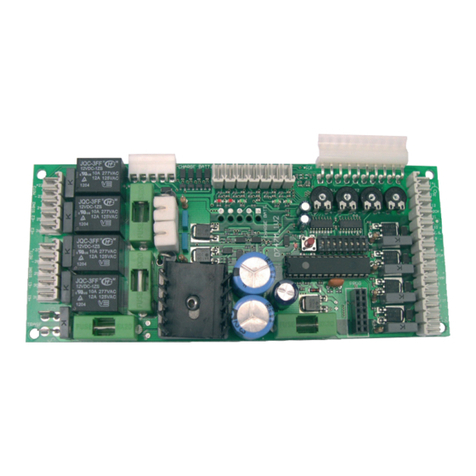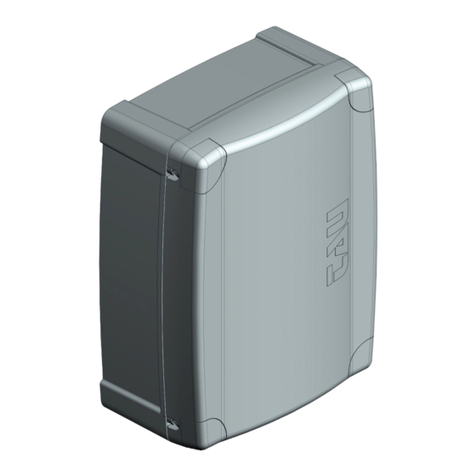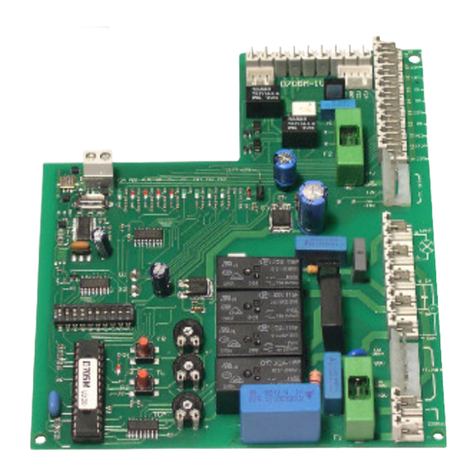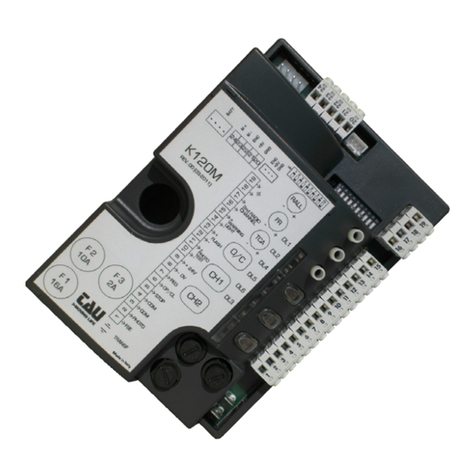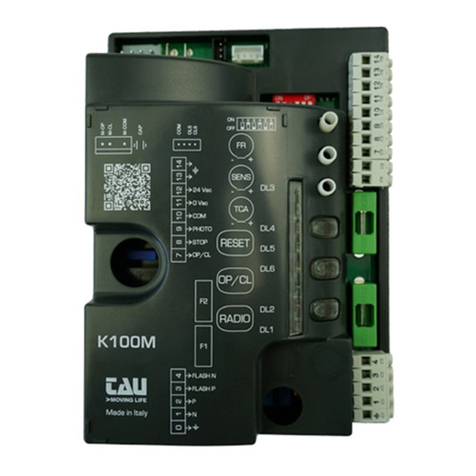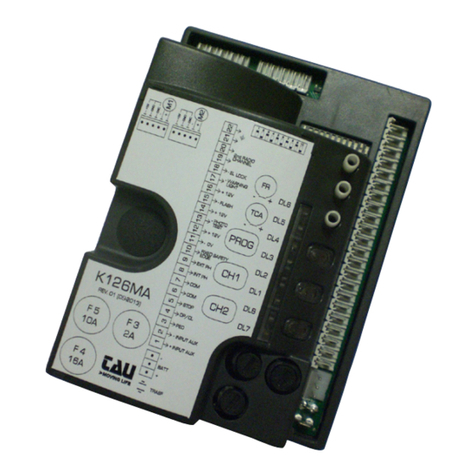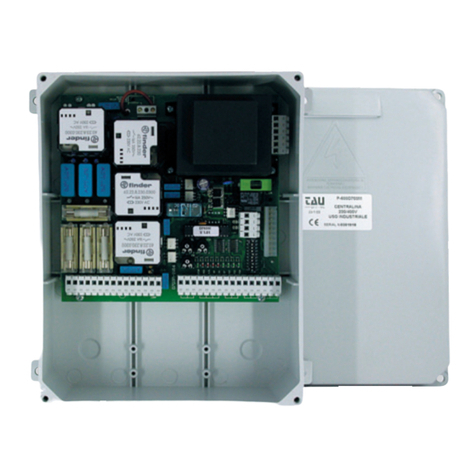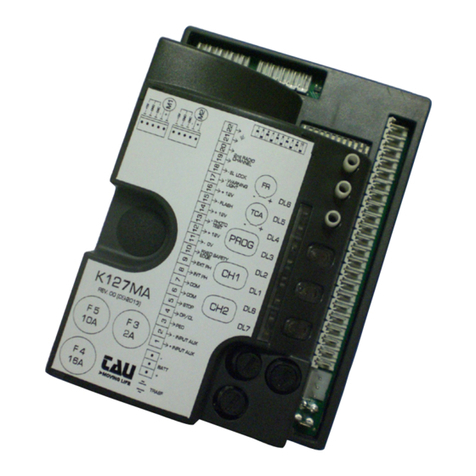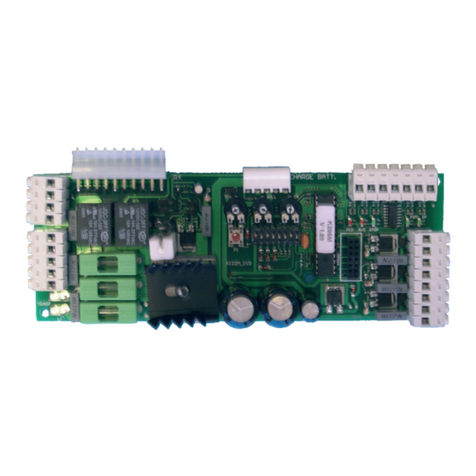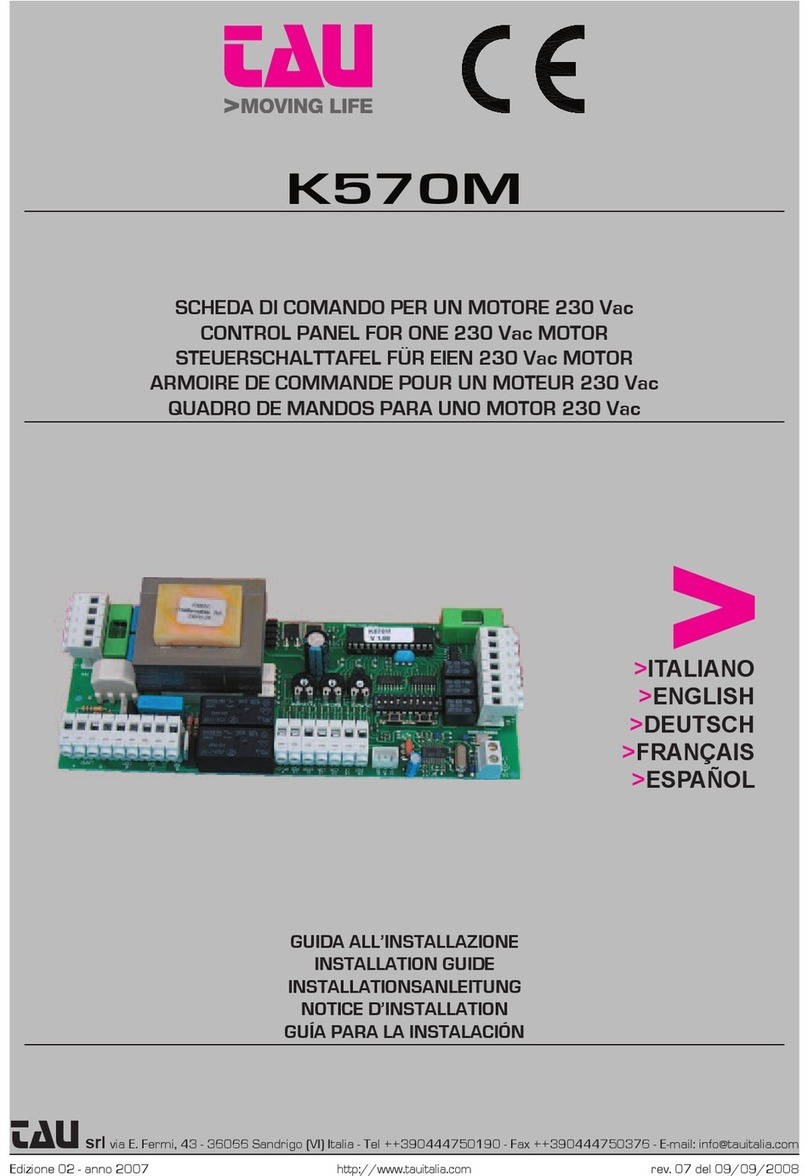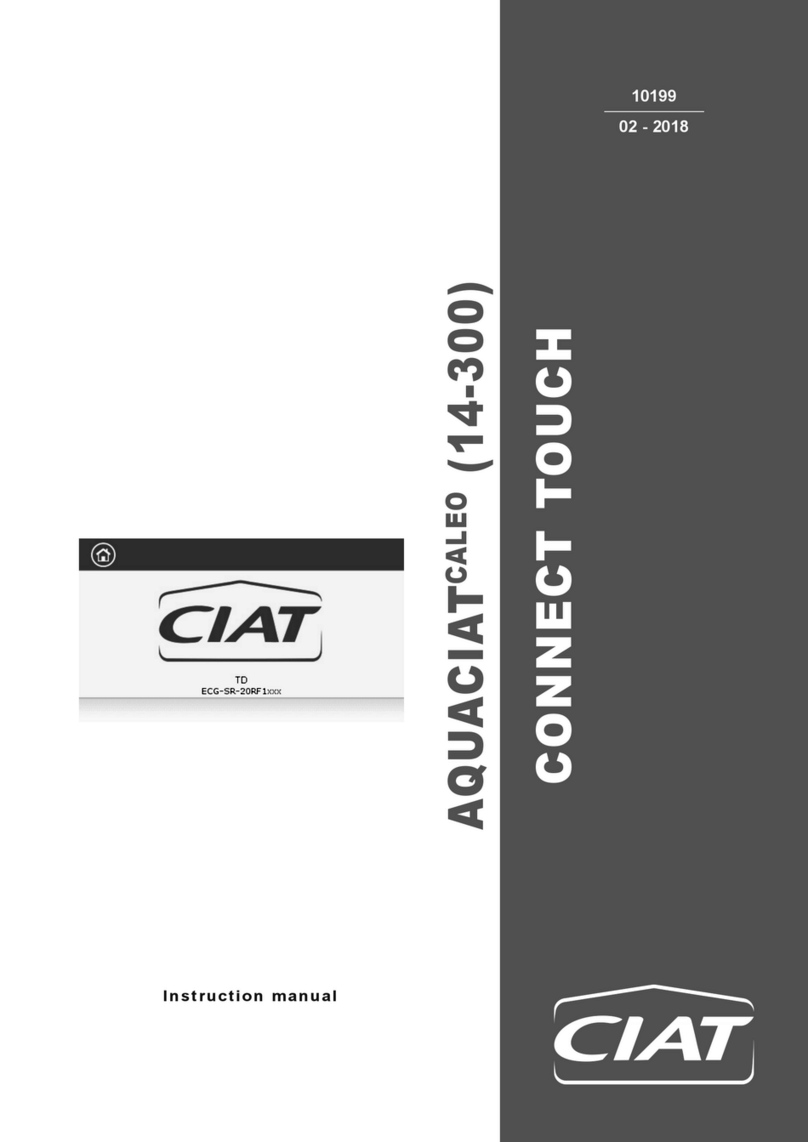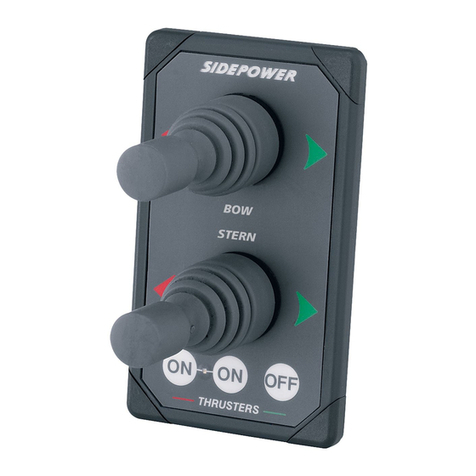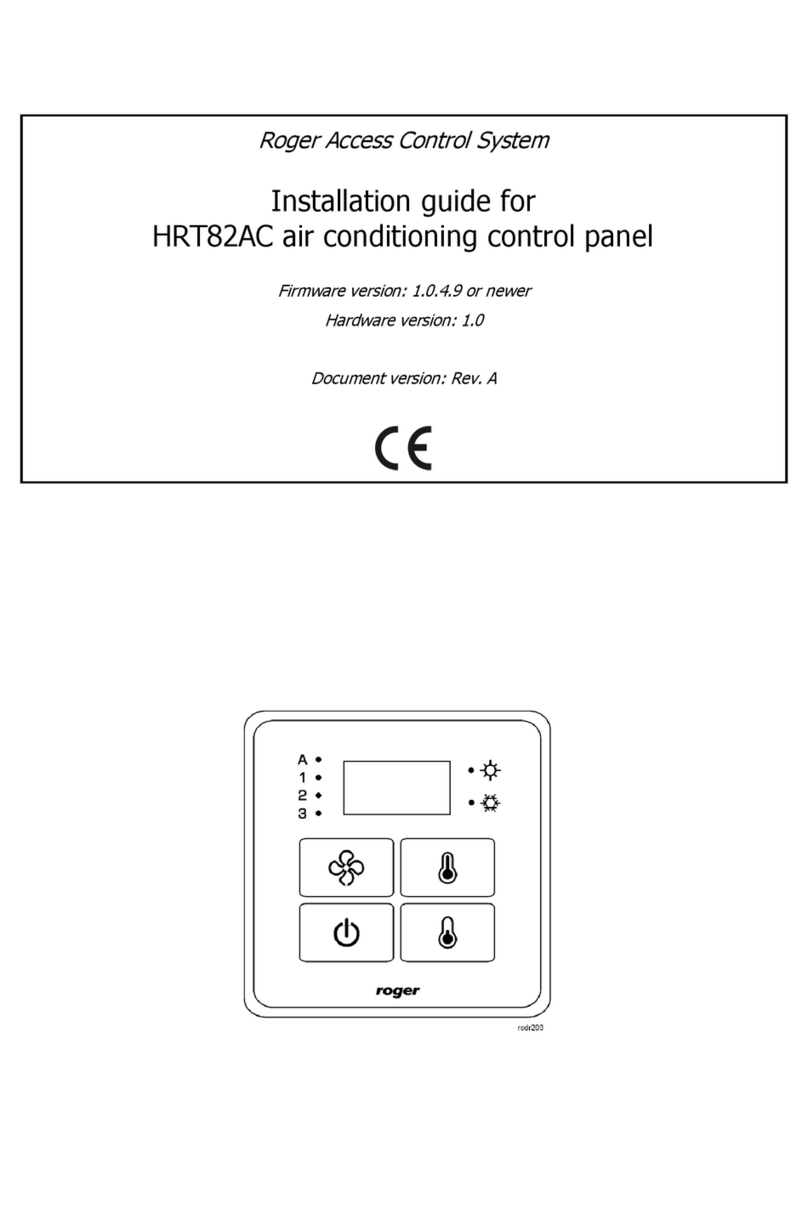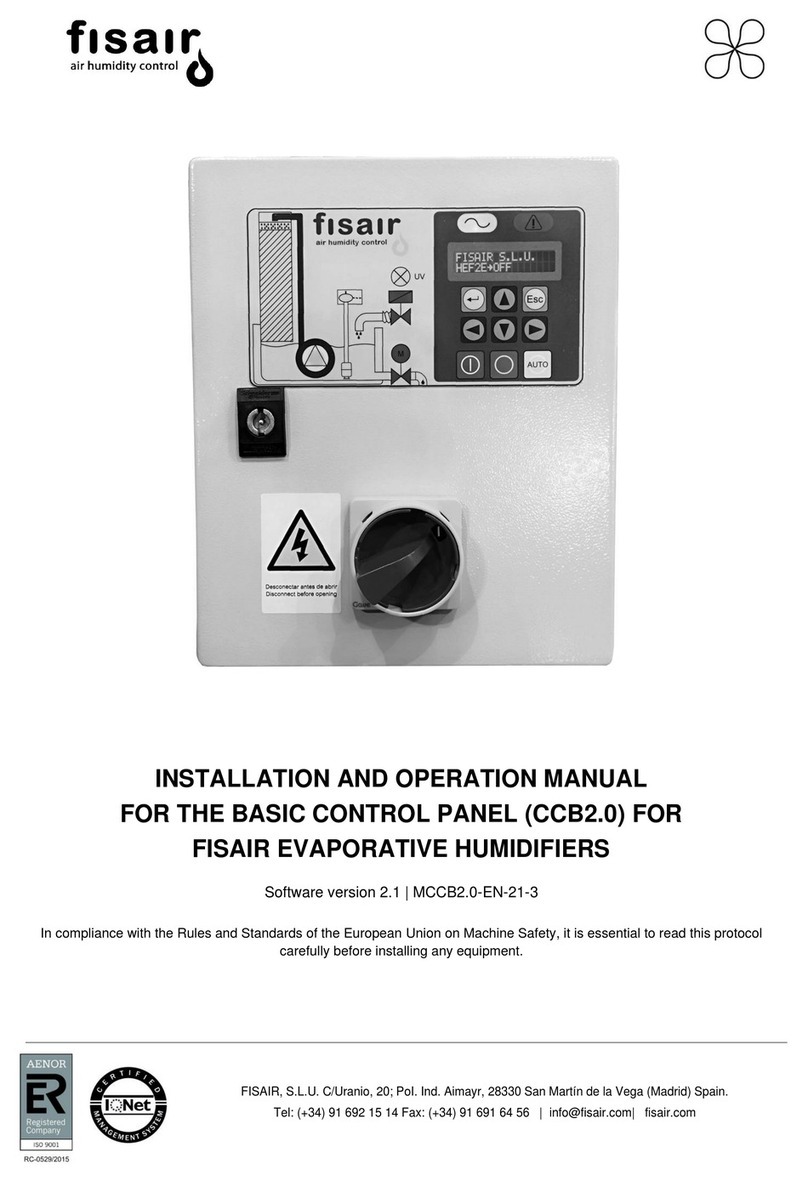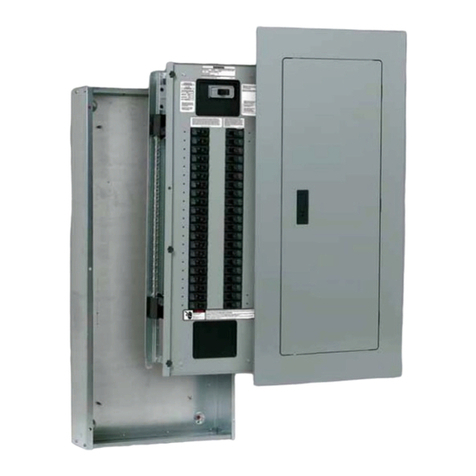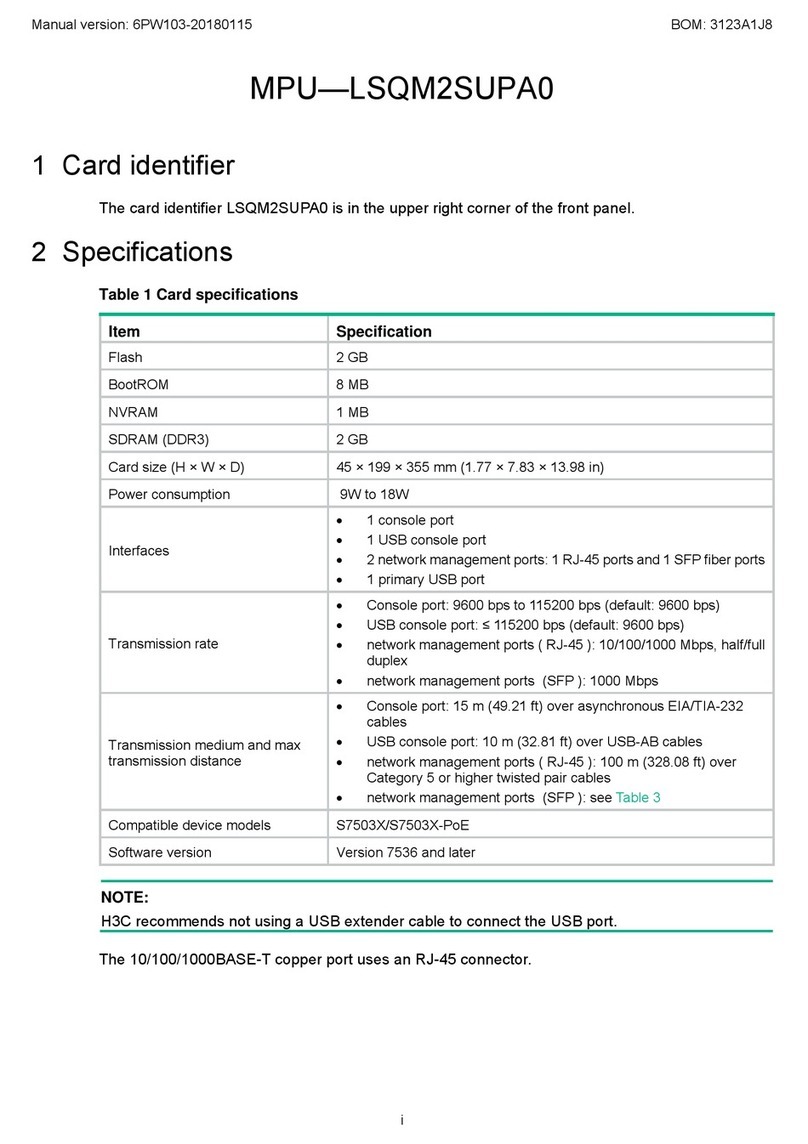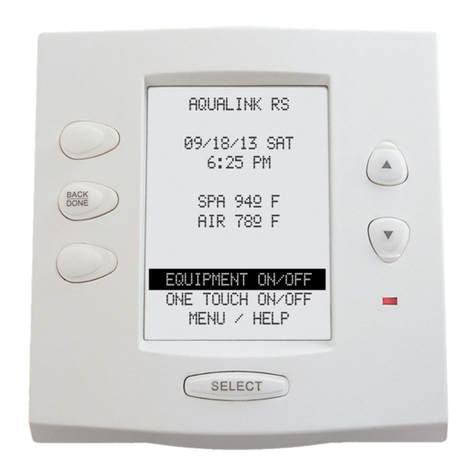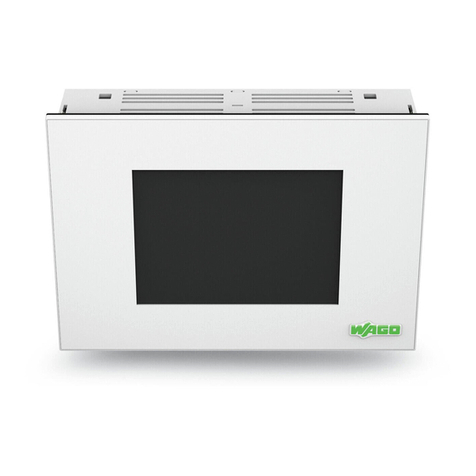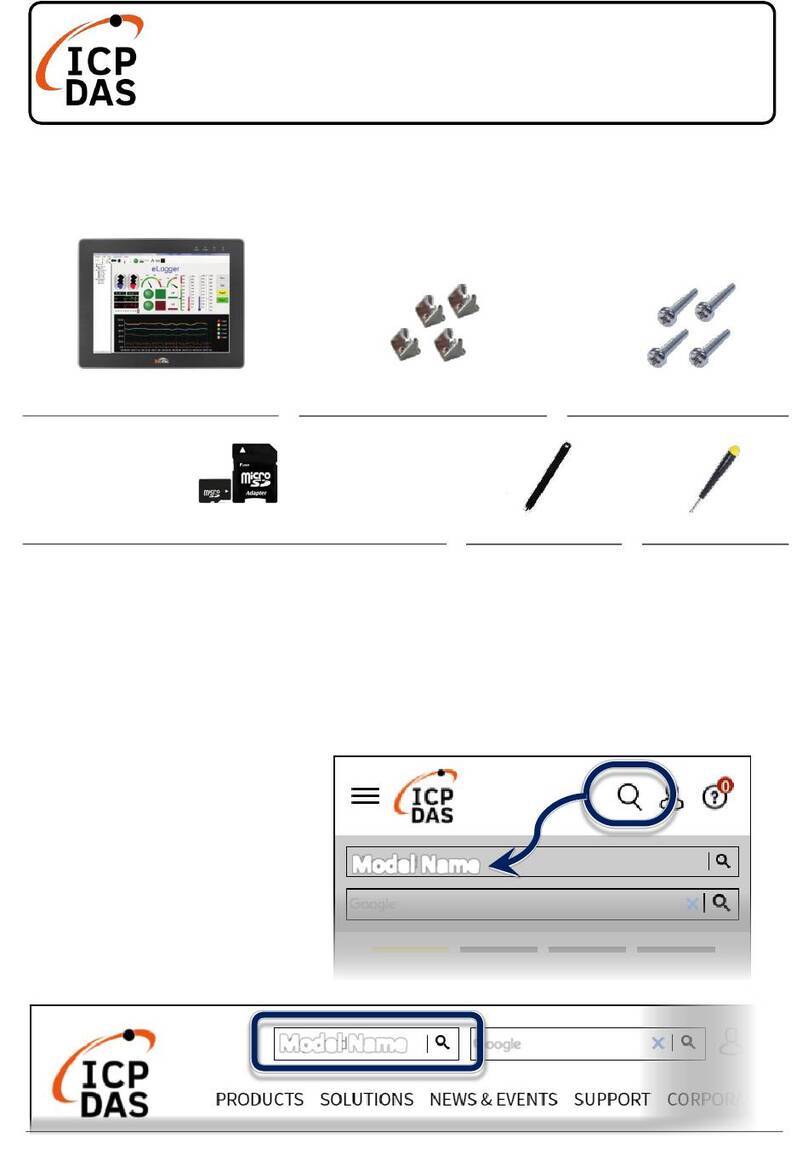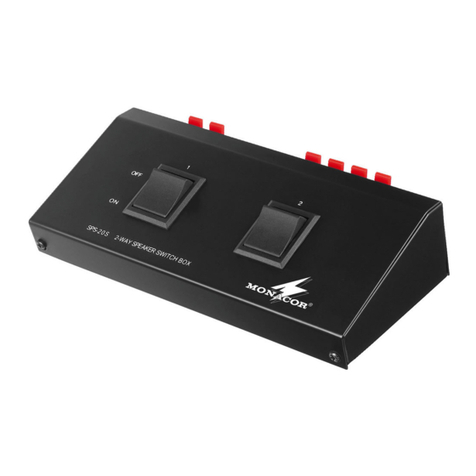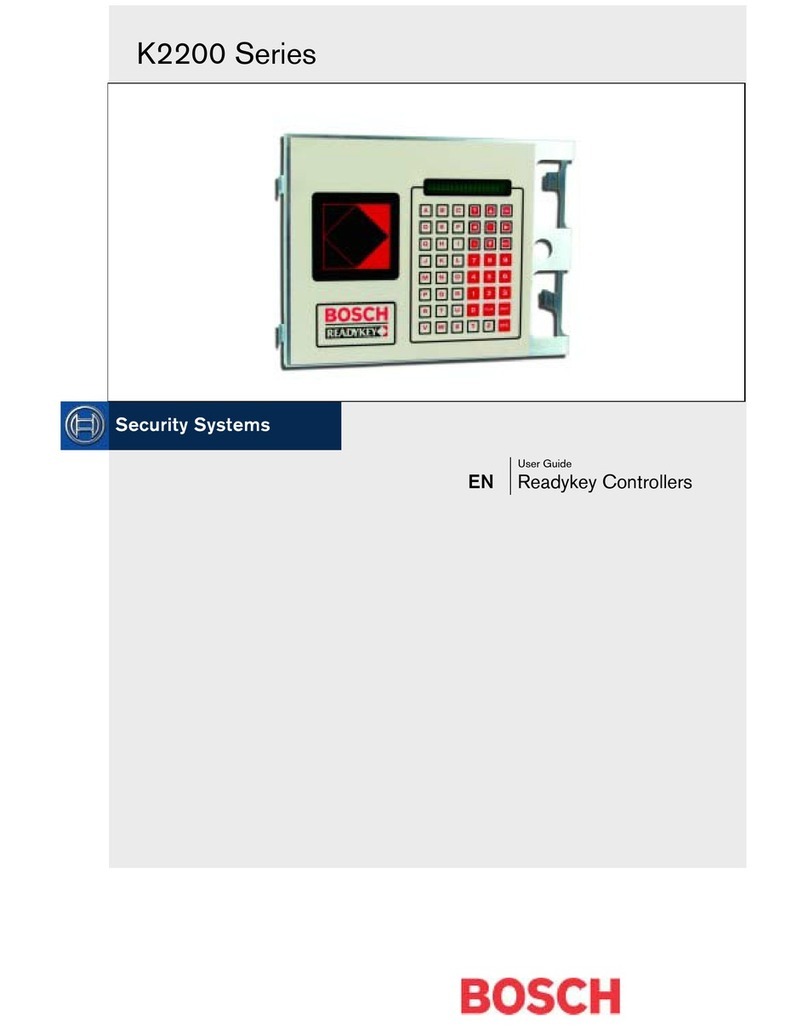tau K123M User manual

1
K123M
GUIDA ALL’INSTALLAZIONE
INSTALLATION GUIDE
INSTALLATIONSANLEITUNG
NOTICE D’INSTALLATION
GUÍA PARA LA INSTALACIÓN
K123M
Quadro di comando per motoriuttore MASTER12Q
Control panel for MASTER12Q gearmotor
Steuerplatine für den getriebemotor MASTER12Q
Logique de commande pour motoréducteur MASTER12Q
Panel de mandos para motorreductor MASTER12Q
Via Enrico Fermi, 43 - 36066 Sandrigo (VI) Italia
Tel +39 0444 750190 - Fax +39 0444 750376
info@tauitalia.com - www.tauitalia.com
IT - Istruzioni originali
D-MNL0K123M 02-05-2016 - Rev.19

2
K123M
DL1
DL2
DL3
DL4
DL5
DL6
2nd radio
channel
Pedestrian
Antenna
Encoder
Open/Close
Stop
Common
Photocells
Positive +
Negative -
Signal
Gate open
warning light
max. 3W
M
Battery
Flashing
light
18 Vdc
max. 20W
Common
Photocell
Fixed safety edge
TX = Transmitter
RX = Receiver
M = Motor
SCHEMA CABLAGGIO K123M
K123M WIRING DIAGRAM
SCHALTPLAN DER K123M
SCHÉMA CÂBLAGE K123M
ESQUEMA DEL CABLEADO K123M
DL1
DL2
DL3
DL4
DL5
DL6
2nd radio
channel
Pedestrian
Antenna
Encoder
Open/Close
Stop
Common
Photocells
Positive +
Negative -
Signal
Gate open
warning light
max. 3W
M
Battery
Flashing
light
18 Vdc
max. 20W
Common
Photocell
Fixed safety edge
TX = Transmitter
RX = Receiver
M = Motor
DL1
DL2
DL3
DL4
DL5
DL6
2nd radio
channel
Pedestrian
Antenna
Encoder
Open/Close
Stop
Common
Photocells
Positive +
Negative -
Signal
Gate open
warning light
max. 3W
M
Battery
Flashing
light
18 Vdc
max. 20W
Common
Photocell
Fixed safety edge
TX = Transmitter
RX = Receiver
M = Motor

3
K123M
DL1
DL2
DL3
DL4
DL5
DL6
2nd radio
channel
Pedestrian
Antenna
Encoder
Open/Close
Stop
Common
Photocells
Positive +
Negative -
Signal
Gate open
warning light
max. 3W
M
Battery
Flashing
light
18 Vdc
max. 20W
Common
Photocell
Fixed safety edge
TX = Transmitter
RX = Receiver
M = Motor

4
K123M
DICHIARAZIONE DI INCORPORAZIONE DEL COSTRUTTORE
(ai sensi della Direttiva Europea 2006/42/CE AlI. II.B)
Fabbricante: TAU S.r.l.
Indirizzo: Via E. Fermi, 43
36066 Sandrigo (Vi)
ITALIA
Dichiara sotto la propria responsabilità che il prodotto: Centrale di comando
realizzato per il movimento automatico di: Cancelli Scorrevoli
per uso in ambiente: Condominiale / Industriale
completo di: -
Modello: K123M
Tipo: K123M
Numero di serie: vedi etichetta argentata
Denominazione commerciale: Quadro di comando per motoriduttore
MASTER12Q
È realizzato per essere incorporato su una chiusura (cancello scorrevole) o per essere assemblato con altri dispositivi
al ne di movimentare una tale chiusura per costituire una macchine ai sensi della Direttiva Macchine 2006/42/CE.
Dichiara inoltre che questo prodotto è conforme ai requisiti essenziali di sicurezza delle seguenti ulteriori direttive
CEE:
- 2006/95/CE Direttiva Bassa Tensione
- 2004/108/CE Direttiva Compatibilità Elettromagnetica
ed, ove richiesto, alla Direttiva:
- 1999/5/CE Apparecchiature Radio e apparecchiature terminali di telecomunicazione
Dichiara inoltre che non è consentito mettere in servizio il macchinario no a che la macchina in cui sarà
incorporato o di cui diverrà componente sia stata identicata e ne sia stata dichiarata la conformità alle condizioni
della Direttiva 2006/42/CE.
Si impegna a trasmettere, su richiesta adeguatamente motivata delle autorità nazionali, informazioni pertinenti sulle
quasi-macchine.
Sandrigo, 27/11/2014
Il Rappresentante Legale
_________________________________________
Loris Virgilio Danieli
Nome e indirizzo della persona autorizzata a costituire la documentazione tecnica pertinente:
Loris Virgilio Danieli - via E. Fermi, 43 - 36066 Sandrigo (Vi) Italia
ITALIANO

5
K123M
AVVERTENZE
Il presente manuale è destinato solamente al personale tecnico qualicato per l’installazione. Nessuna
informazione contenuta nel presente fascicolo può essere considerata d’interesse per l’utilizzatore
nale. Questo manuale è allegato alla centralina K123M montata sul motoriduttore MASTER12Q, non
deve pertanto essere utilizzato per prodotti diversi!
Avvertenze importanti:
Togliere l’alimentazione di rete alla scheda prima di accedervi.
La centralina K123M è destinata al comando di un motoriduttore elettromeccanico in corrente continua
per l’automazione di cancelli scorrevoli.
Ogni altro uso è improprio e, quindi, vietato dalle normative vigenti.
È nostro dovere ricordare che l’automazione che state per eseguire, è classicata come “costruzione
di una macchina” e quindi ricade nel campo di applicazione della direttiva europea 2006/42/CE (Di-
rettiva Macchine).
Questa, nei punti essenziali, prevede che:
- l’installazione deve essere eseguita solo da personale qualicato ed esperto;
- chi esegue l’installazione dovrà preventivamente eseguire “l’analisi dei rischi” della macchina;
- l’installazione dovrà essere fatta a “regola d’arte”, applicando cioè le norme;
- inne dovrà essere rilasciata al proprietario della macchina la”dichiarazione di conformità”.
Risulta chiaro quindi che l’installazione ed eventuali interventi di manutenzione devono essere ef-
fettuati solo da personale professionalmente qualicato, in conformità a quanto previsto dalle leggi,
norme o direttive vigenti.
Nella progettazione delle proprie apparecchiture, TAU rispetta le normative applicabili al prodotto (ve-
dere la dichiarazione di conformità allegata); è fondamentale che anche l’installatore, nel realizzare
gli impianti, prosegua nel rispetto scrupoloso delle norme.
Personale non qualicato o non a conoscenza delle normative applicabili alla categoria dei “cancelli e
porte automatiche” deve assolutamente astenersi dall’eseguire installazioni ed impianti.
Chi non rispetta le normative è responsabile dei danni che l’impianto potrà causare!
Si consiglia di leggere attentamente tutte le istruzioni prima di procedere con l’installazione.
Installazione
Prima di procedere assicurarsi del buon funzionamento della parte meccanica. Vericare inol-
tre che il gruppo motoriduttore sia stato installato correttamente seguendo le relative istru-
zioni. Eseguiti questi controlli, assicurarsi che il motoriduttore non abbia un assorbimento
durante il movimento superiore a 3 A (per un corretto funzionamento del quadro di comando).
L’INSTALLAZIONE DELL’APPARECCHIATURA DEVE ESSERE EFFETTUATA “A REGOLA D’AR-
TE” DA PERSONALE QUALIFICATO COME DISPOSTO DAL D.M. 37/08.
NB : si ricorda l’obbligo di mettere a massa l’impianto nonché di rispettare le normative sulla
sicurezza in vigore in ciascun paese.
LA NON OSSERVANZA DELLE SOPRAELENCATE ISTRUZIONI PUÒ PREGIUDICARE IL BUON
FUNZIONAMENTO DELL’APPARECCHIATURA E CREARE PERICOLO PER LE PERSONE, PER-
TANTO LA “CASA COSTRUTTRICE” DECLINA OGNI RESPONSABILITÀ PER EVENTUALI MAL
FUNZIONAMENTI E DANNI DOVUTI ALLA LORO INOSSERVANZA.
ITALIANO

6
K123M
SCHEDA COMANDO PER MOTORIDUTTORE MASTER12Q
• LOGICA CON MICROPROCESSORE
• STATO DEGLI INGRESSI VISUALIZZATO DA LEDs
• FUNZIONE “INGRESSO PEDONALE”
• CIRCUITO DI LAMPEGGIO INCORPORATO
•
SENSORE AD ENCODER PER RILEVAMENTO OSTACOLI ED AUTOAPPRENDIMENTO DELLA
CORSA
• CONNETTORE PER RICEVENTE
• CONNETTORE PER BATTERIA
• SCHEDA CARICA BATTERIA (INTEGRATA)
• DIAGNOSTICA DEL DIFETTO FUNZIONE VISUALIZZATO DA LED
ATTENZIONE:
- non utilizzare cavi unilari (a conduttore unico), es. quelli citofonici, al ne di evitare inter-
ruzioni sulla linea e falsi contatti;
- non riutilizzare vecchi cavi pre-esistenti
- si consiglia di utilizzare il cavo TAU cod. M-03000010CO per il collegamento dei motori alla
centrale di comando.
COLLAUDO
A collegamento ultimato:
• I Leds verdi devono essere tutti accesi (corrispondono ciascuno ad un ingresso Normalmente
Chiuso). Si spengono solo quando sono interessati i comandi ai quali sono associati.
• I Leds rossi devono essere tutti spenti (corrispondono ciascuno ad un ingresso Normalmente
Aperto) si accendono solo quando sono interessati i comandi ai quali sono associati.
CARATTERISTICHE TECNICHE
Alimentazione scheda 13,5V AC - 50 Hz
Potenza nominale motore c.c. 100 W
Fusibile rapido protezione alimentazione ingresso 13,5 Vac (F1 - 5x20) F 16 A
Fusibile rapido protezione motore (F2 - 5x20) F 16 A
Fusibile rapido protezione ausiliari 18 V dc (F3 - 5x20) F 2 A
Fusibile rapido protezione BATTERIA (F4 - 5x20) F 10A
Tensione circuiti alimentazione motore 18V DC
Tensione alimentazione circuiti dispositivi ausiliari 18V DC
Tensioni alimentazioni circuiti logici 5V DC
Temperatura di funzionamento -20 °C ÷ +55 °C
COLLEGAMENTI ALLA MORSETTIERA
Morsetti Funzione Descrizione
1 - 2 MOTORE uscita alimentazione motore 18V DC;
3 - 4 AUX uscita ausiliari 18V DC max. 15 W (3 = NEGATIVO - 4 = POSITI-
VO) per fotocellule, relay, ricevitori, etc...;
5 - 6 TX FOTOCELLULA uscita 18V DC fotocellula trasmittente -fototest- (5 = NEGATIVO - 6
= POSITIVO) max. nr. 1 trasmettitore fotocellule;
7 - 8 LAMPEGGIANTE
uscita 18V DC max. 20W alimentazione lampeggiante
(7 = NEGATIVO - 8 = POSITIVO), lampeggio fornito dalla centrale,
veloce in chiusura e lento in apertura;
ITALIANO

7
K123M
9 - 10 SPIA CANCELLO
APERTO
uscita 18V DC max. 3W alimentazione spia cancello aperto e in
movimento (9 = NEGATIVO - 10 = POSITIVO);
11 - 13 BORDO
SENSIBILE
ingresso N.C. bordo sensibile elettromeccanico - interviene du-
rante l’apertura bloccando e richiudendo il cancello per ~20 cm
(11 = C.F. - 13 = COM);
12 - 13 FOTOCELLULE
ingresso N.C. fotocellule - interviene durante la chiusura o anche
durante l’apertura, vedi dip-switch nr. 3
(12 = FOT - 13 = COM);
Nota: il trasmettittore della fotocellula deve sempre essere
alimentato dai morsetti nr 5 e nr 6, in quanto su di esso si
effettua la verica del sistema di sicurezza (Fototest). Senza
questo collegamento, la centralina non funziona. Per elimina-
re la verica del sistema di sicurezza, o quando non si usano
le fotocellule, porre il dip-switch nr 6 in OFF.
14 - 15 STOP
ingresso N.C. pulsante STOP - Arresta il cancello dovunque
si trovi, inibendo temporaneamente la chiusura automatica, se
programmata (14 = COM - 15 = STOP);
Nota: al pulsante STOP è collegato un microinterruttore di si-
curezza sblocco. Se l’ingresso STOP rimane aperto per più di
5 secondi, la successiva manovra sarà di RIALLINEAMENTO
(vedi “Ripristino funzionamento automatico”). Il microinterru-
tore va collegato in serie ad altri eventuali pulsanti di STOP.
14 - 16 APRE/CHIUDE
ingresso N.A. pulsante APRE/CHIUDE - Comanda l’apertura e
la chiusura del cancello ed è regolato nel funzionamento dai dip-
switches 2 e 3 (14 = COM - 16 = A/C);
14 - 17 PEDONALE
ingresso N.A. pulsante PEDONALE - Comanda l’apertura e la
chiusura parziale del cancello per ~1 m di corsa ed è regolato nel
funzionamento dai dip-switches 2 e 3
(14 = COM - 17 = PED);
18 - 19 2° CH RADIO
uscita 2° canale radio - per comandare un’altra automazione o
accendere luci, etc... (contatto pulito N.A.);
Nota: per il collegamento di altri dispositivi al 2° canale ra-
dio, quali accensione luci, comando pompe o carichi im-
portanti, utilizzare un relè ausiliario di potenza con portata
adeguata ai dispositivi da collegare, altrimenti si potrebbero
avere malfunzionamenti dovuti a disturbi indotti (con rice-
vente collegata).
20 - 21 ANTENNA ingresso antenna radioricevente ad innesto solo per ricevitori
40,665 MHz (20 = SEGNALE - 21 = MASSA);
22 - 23 - 24 ENCODER alimentazione e ingresso encoder (22 = BLU NEGATIVO -
23 = MARRONE positivo - 24 = BIANCO segnale);
25 - 26 BATTERIA ingresso batteria 12V - 7,2Ah;
FS1 - FS2 ALIMENTAZIONE
ingresso alimentazione scheda 13,5V AC - Alimentato dal
trasformatore toroidale riposto nell’apposito vano del motore
MASTER12Q e protetto da fusibile sull’alimentazione 230V AC;
PROCEDURA DI MEMORIZZAZIONE
ATTENZIONE: Dopo aver alimentato il quadro di comando attendere 2 sec. prima di iniziare a
svolgere le manovre di regolazione.
Nota: il cancello deve necessariamente avere i necessari fermi di sicurezza sia in apertura che
in chiusura.
ITALIANO

8
K123M
Terminata l’installazione dell’automazione:
1_ portare il cancello a 1 m ca. dalla battuta in chiusura;
2_ posizionare il dip-switch nr. 8 in ON;
3_ comandare l’automazione agendo su uno dei seguenti ingressi: A/C, radiocomando o pulsante
scheda.
4_ il cancello deve cominciare a chiudere.
Nota: nel caso dovesse aprirsi, sospendere la programmazione resettando il quadro elettrico
(togliere l’alimentazione al quadro per almeno 5 sec. e rimettere il dip-switch nr. 8 in OFF), e
quindi a quadro disalimentato invertire tra di loro i li di alimentazione del motore. Riprendere
poi la procedura dal punto 1.
5_ effettuata la chiusura, trascorso un tempo di circa 2 sec., viene eseguita automaticamente un’a-
pertura totale;
6_ ad apertura completata, posizionare il dip-switch nr. 8 in OFF;
7_ l’automazione è ora pronta per il funzionamento.
Effettuare le regolazioni logiche.
Nota: agendo su qualsiasi regolazione del quadro di comando (trimmer o dip-switches) è ne-
cessario effettuare una manovra completa (apertura e chiusura) dell’automazione per rendere
attive le nuove impostazioni.
REGOLAZIONI LOGICHE
TRIMMER
RALL. regolazione distanza di rallentamento: da 10 a 100 cm ca.;
T.C.A. regolazione Tempo di Chiusura Automatica: da 3 a 255 secondi ca. (vedi dip-switch
nr. 1);
FR. regolazione sensibilità rilevamento ostacoli.
NOTA: ruotando il TRIMMER FR. in senso orario si diminuisce la sensibilità del
motoriduttore sull’ostacolo e quindi aumenta la forza di spinta; viceversa,
ruotandolo in senso antiorario, aumenta la sensibilità del motoriduttore
sull’ostacolo e diminuisce la forza di spinta.
Dip switch
Nota: non utilizzare utensili metallici (es. cacciaviti) per effettuare le regolazioni dei dip
switch, al ne di evitare cortocircuiti con il pettine della radio ricevente.
1CHIUSURA
AUTOMATICA
On ad apertura completata, la chiusura del cancello è automatica trascorso
un tempo impostato sul trimmer T.C.A.;
Off la chiusura necessita di un comando manuale;
22 / 4 TEMPI
On
ad automazione funzionante, una sequenza di comandi di apertura/
chiusura induce il cancello ad una APERTURA-CHIUSURA-APERTURA-
CHIUSURA, etc.
Off
nelle stesse condizioni, la stessa sequenza di comandi induce il cancello
ad una APERTURA-STOP-CHIUSURA-STOP-APERTURA-STOP, etc.
(funzione passo-passo) (vedi anche dip switch 4);
3
INTERVENTO
FOTOCELLULE
IN APERTURA
On
durante la fase di apertura la fotocellula interviene arrestando il cancello
no a rimozione dell’ostacolo rilevato. In fase di chiusura provoca l’arresto
seguito dalla totale riapertura del cancello;
Off durante la fase di apertura la fotocellula non interviene, mentre in fase di
chiusura si comporta come in modalità on;
4NO REVERSE On il cancello si comporta come stabilito dal dip switch nr. 2
Off il cancello ignora i comandi di chiusura durante l’apertura;
ITALIANO

9
K123M
5PRE-
LAMPEGGIO
On la funzione prelampeggio è inserita;
Off la funzione prelampeggio è disinserita;
6FOTOTEST
On la funzione “verica delle fotocellule” è inserita;
Off la funzione “verica delle fotocellule” è disinserita.
Nota: da utilizzare quando non si usano le fotocellule;
7
RICHIUDE
DOPO
FOTOCELLULA
On in seguito all’intervento del contatto fotocellula (ingresso 12 - 13), l’auto-
mazione si chiude automaticamente dopo 5 secondi;
Off funzione disinserita;
8MEMO
On si abilita la funzione di memorizzazione per l’autoapprendimento della
corsa;
Off posizione in cui lasciare il dip-switch al termine della procedura di me-
morizzazione.
Funzione orologio:
È possibile utilizzare un timer (esempio settimanale) collegato all’ingresso del pulsante apre-chiude
per mantenere aperto il cancello in determinate fascie orarie e permetterne poi la richiusura auto-
maitca.
LED DI DIAGNOSI
DL1 led rosso di segnalazione pulsante PEDONALE
DL2 led rosso di segnalazione pulsante APRE/CHIUDE
DL3 led rosso di segnalazione ERRORI
DL4 led verde di segnalazione pulsante di STOP
DL5 led verde di segnalazione FOTOCELLULA
DL6 led verde di segnalazione BORDO SENSIBILE
DL7 led verde di segnalazione CARICABATTERIE
CARATTERISTICHE DELLA K123M
LED - DL3
Il led, oltre ad indicare la presenza dell’alimentazione, segnala eventuali errori con una serie di lam-
peggi predeniti:
sempre acceso: funzionamento regolare;
1 lampeggio: tensione della batteria tampone inferiore a 11,3 Vdc;
Controllare l’alimentazione di rete, caricare la batteria, sostituire la batteria;
2 lampeggi: errore fototest;
Disabilitare fototest (dip-switch 6 in OFF), vericare funzionamento fotocellule e loro collegamento;
3 lampeggi: mancanza tensione di rete;
Controllare interruttore magnetotermico (a monte dell’impianto), controllare fusibili;
4 lampeggi: superamento limite max. di corrente;
Picco di eccessivo assorbimento del motoriduttore, controllare l’assenza di ostacoli lungo la corsa del
cancello, vericare l’assorbimento di corrente del motore a vuoto e applicato al cancello;
5 lampeggi: assenza segnale encoder / assenza segnale motore;
Controllare cablaggio, vericare encoder tramite TEST-ENCODER (opzionale);
Controllare cablaggio, vericare che il motore giri liberamente alimentato direttamente dalla batteria,
vericare fusibile F2.
6 lampeggi: presenza ostacolo dopo 5 tentativi di chiusura falliti;
Controllare l’assenza di ostacoli lungo la corsa del cancello e la scorrevolezza dello stesso;
ITALIANO

10
K123M
7 lampeggi: non è stata eseguita alcuna procedura di memorizzazione;
Eseguire procedura di memorizzazione.
L’indicazione di più errori viene eseguita con una pausa di 2 sec. tra una segnalazione e l’altra.
Nel caso di 5 interventi consecutivi (durante la stessa manovra di chiusura) da parte dell’encoder
(rilevazione ostacolo), la centrale apre completamente. Al successivo impulso di comando, entrerà in
fase di corsa rallentata alla ricerca della battuta in chiusura.
SPIA CANCELLO APERTO (18 V DC - max. 3W)
La spia cancello aperto, durante la fase di apertura o chiusura dell’automazione, lampeggia in sincronia
con il lampeggiante per rimanere poi ssa al raggiungimento dell’apertura totale. Una volta completata
anche la fase di chiusura, questa si spegne.
SCHEDA CARICA BATTERIA (INTEGRATA)
Se si collega la batteria, in assenza di rete l’automazione risulta comunque funzionante. Nel caso la
tensione scenda sotto gli 11,3 V DC, l’automazione cessa di funzionare (il quadro di comando rimane
alimentato); quando, invece, scende sotto i 10,2 V DC, la scheda sgancia completamente la batteria
(il quadro di comando non è più alimentato).
RILEVAMENTO OSTACOLI
La funzione di rilevamento ostacoli (impostabile tramite trimmer FR) intervenendo in fase di apertura
dell’automazione provoca una richiusura della stessa di 20 cm ca., mentre in fase di chiusura provoca
un’apertura totale.
ATTENZIONE: la logica del quadro di comando può interpretare un attrito meccanico per un
eventuale ostacolo.
RALLENTAMENTO
Per evitare che il cancello sbatta alla ne della corsa, è possibile impostare (tramite il trimmer RALL) il
rallentamento in apertura e in chiusura su una distanza variabile da 10 a 100 cm. (ruotando il trimmer
in senso orario si aumenta la distanza di rallentamento; viceversa, ruotandolo in senso antiorario la
distanza di rallentamento si accorcia). Si consiglia di impostare la distanza di rallentamento tenendo
conto del peso del cancello e degli attriti meccanici in gioco.
Nota: il pulsante P1 della scheda ha la stessa funzione del tasto APRE/CHIUDE.
APERTURA E CHIUSURA COMANDATA DA OROLOGIO
É possibile comandare l’apertura e la chiusura del cancello mediante un orologio digitale che in uscita
disponga di un contatto relè.
Sarà sufciente collegarlo ai morsetti 14 - 16 (pulsante APRE/CHIUDE) e programmarlo in modo che,
all’ora di apertura desiderata, il contatto relè dell’orologio si chiuda sino all’ora di chiusura voluta (mo-
mento in cui il contatto relè dell’orologio si apre nuovamente, permettendo così la richiusura automatica).
Nota: la richiusura automatica deve essere inserita (Dip-switch nr. 1 in ON).
RIPRISTINO FUNZIONAMENTO AUTOMATICO
Qualora si renda necessario movimentare manualmente la chiusura o l’apertura del cancello, azionare
lo sblocco manuale. Per ripristinare il normale funzionamento (in automatico), occorre specicare:
• se il ripristino avviene successivamente ad un black-out (la scheda resta priva di alimentazione per
un certo tempo), il cancello entrerà in fase di corsa rallentata alla ricerca della battuta di chiusura;
• se il ripristino avviene dopo un intervento manuale (senza interruzioni all’alimentazione della sche-
da), saranno necessarie 4 o 5 manovre complete per fare riallineare il cancello, durante le quali
non verranno osservati i normali rallentamenti e le conseguenti battute d’arresto.
ITALIANO

11
K123M
MALFUNZIONAMENTI: POSSIBILI CAUSE E RIMEDI
L’automazione non parte
a- Vericare con lo strumento (Multimetro) la presenza dell’alimentazione 230Vac;
b- Vericare che i contatti N.C. della scheda siano effettivamente normalmente chiusi (3 led verdi
accesi);
c- Impostare il dip 6 (fototest) su OFF;
d- Aumentare il trimmer FR al massimo;
e- Controllare con lo strumento (Multimetro) che i fusibili siano integri.
Il radiocomando ha poca portata
a- Collegare l’antenna radio sui morsetti presenti sulla scheda ricevente e non sui morsetti 20-21
della scheda di comando (per frequenza 433,92 MHz);
b- Controllare che il collegamento della massa e del segnale dell’antenna non sia invertito;
c- Non eseguire giunzioni per allungare il cavo dell’antenna;
d- Non installare l’antenna in posizioni basse o in posizioni nascoste dalla muratura o dal pila-
stro;
e- Controllare lo stato delle pile del radiocomando.
L’automazione si apre al contrario
Invertire tra loro i collegamenti del motore sulla morsettiera (morsetti 1 e 2);
GARANZIA: CONDIZIONI GENERALI
La garanzia della TAU ha durata di 24 mesi dalla data di acquisto dei prodotti (fa fede il documento
scale di vendita, scontrino o fattura).
La garanzia comprende la riparazione con sostituzione gratuita (franco sede TAU: spese di imballo e
di trasporto sono a carico del cliente) delle parti che presentano difetti di lavorazione o vizi di materiale
riconosciuti dalla TAU.
In caso di intervento a domicilio, anche nel periodo coperto da garanzia, l’utente è tenuto a corrispon-
dere il “Diritto sso di chiamata” per spese di trasferimento a domicilio, più manodopera.
La garanzia decade nei seguenti casi:
• Qualora il guasto sia determinato da un impianto non eseguito secondo le istruzioni fornite
dall’azienda all’interno di ogni confezione.
• Qualora non siano stati impiegati tutti componenti originali TAU per l’installazione dell’automa-
tismo.
• Qualora i danni siano causati da calamità naturali, manomissioni, sovraccarico di tensione,
alimentazione non corretta, riparazioni improprie, errata installazione, o altre cause non impu-
tabili alla TAU.
• Qualora non siano state effettuate le manutenzioni periodiche da parte di un tecnico specia-
lizzato secondo le istruzioni fornite dall’azienda all’interno di ogni confezione.
• Usura dei componenti.
La riparazione o la sostituzione dei pezzi durante il periodo di garanzia non comporta un prolunga-
mento del termine di scadenza della garanzia stessa.
In caso di utilizzo industriale o professionale oppure in caso di impiego simile, tale garanzia ha validità
12 mesi.
ITALIANO

12
K123M
MANUFACTURER’S DECLARATION OF INCORPORATION
(in accordance with European Directive 2006/42/EC App. II.B)
Manufacturer: TAU S.r.l.
Address: Via E. Fermi, 43
36066 Sandrigo (Vi)
ITALY
Declares under its sole responsibility, that the product: Electronic control unit
designed for automatic movement of: Sliding Gates
for use in a: Communities / Industrial
complete with: -
Model: K123M
Type: K123M
Serial number: see silver label
Commercial name: Control panel for MASTER12Q gearmotor
Has been produced for incorporation on an access point (sliding gate) of for assembly with other devices used
to move such an access point, to constitute a machine in accordance with the Machinery Directive 2006/42/EC.
Also declares that this product complies with the essential safety requirements of the following EEC directives:
- 2006/95/EC Low Voltage Directive
- 2004/108/EC Electromagnetic Compatibility Directive
and, where required, with the Directive:
- 1999/5/CE Radio equipment and telecommunications terminal equipment
Also declares that it is not permitted to start up the machine until the machine in which it is incorporated or of
which it will be a component has been identied with the relative declaration of conformity with the provisions of
Directive 2006/42/EC.
The manufacturer undertakes to provide, on sufciently motivated request by national authorities, all information
pertinent to the quasi-machinery.
Sandrigo, 27/11/2014
Legal Representative
_________________________________________
Loris Virgilio Danieli
Name and address of person authorised to draw up all pertinent technical documentation:
Loris Virgilio Danieli - via E. Fermi, 43 - 36066 Sandrigo (Vi) Italy
ENGLISH

13
K123M
WARNINGS
This manual is designed to assist qualied installation personnel only. It contains no information that
may be of interest to nal users. This manual is attached to the K123M control unit mounted on the
MASTER12Q gearmotor, therefore it may not be used for different products!
Important informations:
Disconnect the mains power supply to the board before accessing it.
The K123M control unit is suitable for the control of a direct-current electromechanical gearmotor for
the automation of sliding gates.
Any other use is considered improper and is consequently forbidden by current laws.
Please note that the automation system you are going to install is classi ed as “machine construction”
and therefore is included in the application of European directive 2006/42/EC (Machinery Directive).
This directive includes the following prescriptions:
- Only trained and qualied personnel should install the equipment;
- the installer must rst make a “risk analysis” of the machine;
- the equipment must be installed in a correct and workmanlike manner in compliance with all the
standards concerned;
- after installation, the machine owner must be given the “declaration of conformity”.
This product may only be installed and serviced by qualied personnel in compliance with current,
laws, regulations and directives.
When designing its products, TAU observes all applicable standards (please see the attached decla-
ration of conformity) but it is of paramount importance that installers strictly observe the same stand-
ards when installing the system.
Unqualied personnel or those who are unaware of the standards applicable to the “automatic gates
and doors” category may not install systems under any circumstances.
Whoever ignores such standards shall be held responsible for any damage caused by the
system!
Do not install the unit before you have read all the instructions.
Installation
Before proceeding, make sure the mechanical components work correctly. Also check that the
gear motor assembly has been installed according to the instructions. Then make sure that
the power consumption of the gear motor is not greater than 3A (otherwise the control panel
may not work properly).
THE EQUIPMENT MUST BE INSTALLED “EXPERTLY” BY QUALIFIED PERSONNEL AS RE-
QUIRED BY LAW.
Note: it is compulsory to earth the system and to observe the safety regulations that are in
force in each country.
IF THESE ABOVE INSTRUCTIONS ARE NOT FOLLOWED IT COULD PREJUDICE THE PROPER
WORKING ORDER OF THE EQUIPMENT AND CREATE HAZARDOUS SITUATIONS FOR PEO-
PLE. FOR THIS REASON THE “MANUFACTURER” DECLINES ALL RESPONSIBILITY FOR ANY
MALFUNCTIONING AND DAMAGES THUS RESULTING.
ENGLISH

14
K123M
CONTROL BOARD FOR MASTER12Q GEARMOTOR
• LOGICS WITH MICROPROCESSOR
• STATUS OF INPUTS SIGNALLED BY LEDs
• “PEDESTRIAN GATE” FUNCTION
• INCORPORATED FLASHING CIRCUIT
• ENCODER SENSOR FOR OBSTACLE DETECTION AND SELF-LEARNING OF TRAVEL
• RECEIVER CONNECTOR
• BATTERY CONNECTOR
• BATTERY CHARGER BOARD (INTEGRATED)
• DIAGNOSTICS OF MALFUNCTIONS SIGNALLED BY LED
TESTING
When you have completed the connection:
• All the green LEDs must be on (each of them corresponds to a Normally Closed input). The go off
only when the controls to which they are associated are operated.
•All the red LEDs must be off (each of them corresponds to a Normally Open input). The light up
only when the controls to which they are associated are operated.
ATTENTION:
- do not use single cables (with one single wire), ex. telephone cables, in order to avoid
breakdowns of the line and false contacts;
- do not re-use old pre-existing cables<
- we recommend to use the TAU cable code M-03000010C0 to connect the motors to the
control board.
TECHNICAL CHARACTERISTICS
Board power supply 13,5V AC - 50 Hz
Rated power motor DC 100 W
Fast acting fuse for protection of input power supply 13.5 Vac (F1 - 5x20)
F 16 A
Fast acting fuse for motor protection (F2 - 5x20) F 16 A
Fast acting fuse for protection of auxiliary circuits 18 V dc (F3 - 5x20) F 2 A
Fast acting fuse for protection of battery (F4 - 5x20) F 10 A
Motor power supply circuits voltage 18V DC
Auxiliary device circuits supply voltage 18V DC
Logic circuits supply voltages 5V DC
Operating temperature -20 °C ÷ +55 °C
CONNECTIONS TO TERMINAL BOARD
Terminals Function Description
1 - 2 MOTOR motor supply output 18V DC;
3 - 4 AUX auxiliary circuits output 18V DC max. 15 W (3 = NEGATIVE - 4 =
POSITIVE) for photocells, relays, receivers, etc...;
5 - 6 PHOTOCELL TX 18V DC output for transmitter photocell – phototest - (5 = NEGA-
TIVE - 6 = POSITIVE) max. no. 1 photocell transmitter;
7 - 8 FLASHING LIGHT
18V DC max. 20W output for ashing light supply (7 = NEGA-
TIVE - 8 = POSITIVE), ashing signal supplied by the control
unit, rapid for closing, slow for opening;
ENGLISH

15
K123M
9 - 10 GATE OPEN
WARNING LIGHT
18V DC max. 3W output for supply to open and moving gate
warning light (9 = NEGATIVE - 10 = POSITIVE);
11 - 13 SENSITIVE
EDGE
N.C. input for electromechanical sensitive edge – it cuts in during
the opening manoeuvre, locking and re-closing the gate by ~20
cm (11 = C.F. - 13 = COM);
12 - 13 PHOTOCELLS
N.C. photocell input - it cuts in during the closing or the opening
manoeuvre, see dip-switch no. 3 (12 = FOT - 13 = COM);
Note: the photocell transmitter must always be supplied by
terminals no. 5 and no. 6, since the safety system test (pho-
totest) is carried out on it. Without this connection, the con-
trol unit does not work. To override the testing of the safety
system, or when the photocells are not used, set dip-switch
no. 6 to OFF.
14 - 15 STOP
N.C. input for STOP button – It stops the gate in any position,
temporarily inhibiting its automatic closing, if programmed (14
= COM - 15 = STOP);
NOTE: A safety micro-switch is connected to the STOP push-
button. In case the STOP input remains open for more than 5
seconds, the operator will perform a cycle at a slow speed to
reset the operating parameters to the values originally saved
(see “Restoring automatic operation”). The micro-switch
should be connected in series to further STOP push-buttons
where present.
14 - 16 OPEN/CLOSE
N.O. input for OPEN/CLOSE button - It commands the opening
and closing of the gate and its operation is controlled by dip-
switches 2 and 3 (14 = COM - 16 = A/C);
14 - 17 PEDESTRIAN
N.O. input for PEDESTRIAN button - It commands the partial
opening and closing of the gate for ~1 m of travel and its opera-
tion is controlled by dip-switches 2 and 3
(14 = COM - 17 = PED);
18 - 19 2nd RADIO CH
2nd radio channel output - for control of an additional automation
or for switching on lights, etc... (N.O. clean contact);
Warning: to connect other devices to the 2nd Radio Channel
(area lighting, pumps, etc.), use an additional auxiliary relay
(with receiver connected).
20 - 21 AERIAL plug-in radio-receiver aerial input , for 40.665 MHz receivers only
(20 = SIGNAL - 21 = GROUND);
22 - 23 - 24 ENCODER encoder supply and input (22 = BLUE negative - 23 = BROWN
positive - 24 = WHITE signal);
25 - 26 BATTERY battery 12V - 7,2Ah input;
FS1 - FS2 POWER
SUPPLY
board supply input 13.5 Vac – Powered by the toroidal trans-
former housed in the MASTER12Q motor and protected by a
fuse on the 230 Vac power supply ;
MEMORIZATION PROCEDURE
WARNING: After powering the control panel, wait 2 seconds before you start performing the
adjustment operations.
Note: The gate must be equipped with the opening and closing safety stops.
When you have completed the installation procedures :
1_ bring the gate to approx. 1 m from the closing travel limit;
2_ set dip-switch no. 8 to ON;
ENGLISH

16
K123M
3_ operate the automation using one of the following inputs: A/C, radio control or card button.
4_ the gate must start to close.
Note: if it opens, stop the programming procedure by resetting the electric panel (disconnect
the power supply to the panel for at least 5 sec. and set dip-switch no. 8 to OFF); with the con-
trol panel disconnected, exchange the motor supply wires. Restart the procedure from point 1.
5_ when the gate has closed, after approximately 2 seconds a complete opening manoeuvre is ex-
ecuted automatically;
6_ when the gate has opened, set dip-switch no. 8 to OFF;
7_ the automation is now ready for operation.
Make the logic adjustments.
Nota: when any adjusting devices (trimmers or dip-switches) on the control panel are operated,
a complete manoeuvre must be carried out in order for the new settings to take effect.
LOGIC ADJUSTMENTS
TRIMMER
RALL. slowdown distance adjustment: from about 10 to 100 cm;
T.C.A. Automatic Closing time adjustment: from about 3 to 255 seconds (see dip-switch
no. 1);
FR. obstacle detection sensitivity adjustment.
NOTE: by rotating the TRIMMER FR. clockwise the sensitivity of the gearmotor to
obstacles diminishes and therefore the thrust force increases; vice-versa, by
rotating it counter-clockwise, the sensitivity of the gearmotor to obstacles
increases and therefore the thrust force diminishes.
Dip switch
Do not use metal tools (such as a screwdriver) to set the dipswitches to prevent risks
of short circuit with the radio receiver terminals.
1AUTOMATIC
CLOSING
On when the gate has opened, it closes automatically after the time estab-
lished through the T.C.A. trimmer;
Off the closing manoeuvre requires a manual command;
22 / 4 STROKE
On when the automation is operational, a sequence of opening/closing com-
mands causes the gate to OPEN-CLOSE-OPEN-CLOSE etc.
Off
under the same circumstances, the same sequence of commands causes
the gate to OPEN-STOP-CLOSE-STOP-OPEN-STOP, etc. (step-by-step
function) (see also dip switch 4);
3
OPENING
PHOTOCELLS
OPERATION
On
during the opening phase, the photocell cuts in, stopping the gate until the
detected obstacle has been removed. During the closing phase, it causes
the gate to stop and then to open again all the way;
Off during the opening phase the photocell does not cut in, while during the
closing phase it behaves in the same way as it does when in the ON mode;
4NO REVERSE On the gate behaves as established by dip switch no. 2
Off the gate ignores the closing commands during the opening manoeuvre;
5PRE-
FLASHING
On the pre-ashing function is enabled;
Off the pre-ashing function is disabled;
6PHOTOCELL
TEST
On the “photocell test” function is enabled;
Off the “photocell test” function is disabled.
Note: to be used when the photocells are not used;
7
CLOSE
AFTER
PHOTOCELL
On following the connection of the photocell contact (input 12 - 13), the gate
closes automatically after 5 seconds;
Off function disconnected;
ENGLISH

17
K123M
8MEMO
On the memorization function is enabled for self-learning of the travel;
Off leave the dip-switch in this position when the memorization procedure
has been completed.
Clock function:
A timer can be connected to the open-close pushbutton in order to keep the gate open at certain times
during the day, after which it reverts to automatic closing.
DIAGNOSTICS LED
DL1 PEDESTRIAN button red LED signal
DL2 OPEN/CLOSE button red LED signal
DL3 ERRORS red LED signal
DL4 STOP button green LED signal
DL5 PHOTOCELL green LED signal
DL6 SENSITIVE EDGE green LED signal
DL7 BATTERY CHARGER green LED signal
K123M CHARACTERISTICS
LED - DL3
The LED, besides indicating that the power supply is connected, also signals errors with a series of
pre-dened ashes:
steady light: normal operation;
1 ash: buffer battery voltage lower than 11.3 Vdc;
Check the mains power supply, charge the battery, replace the battery;
2 ashes: phototest error;
Disable phototest (dip-switch 6 OFF), check operation and connection of photocells;
3 ashes: power failure;
Check the thermal-magnetic circuit breaker (upstream from system), check the fuses;
4 ashes: max current limit exceeded;
Gearmotor has exceeded absorption limits, check for obstacles across the path of the gate, check the
current absorption of the motor when loadless and under load;
5 ashes: absence of encoder signal / no motor signal;
Check wiring, check encoder through TEST-ENCODER (optional);
Check wiring, check that the motor rotates freely when powered directly by battery, check fuse F2;
6 ashes: presence of obstacle after 5 failed attempts to close;
Make sure there are no obstacles across the path of the gate and that it slides smoothly;
7 ashes: no memorization procedure has been executed;
Execute memorization procedure.
Multiple errors are signalled by a 2-second pause between signals.
If the encoder is activated 5 consecutive times during the same closing manoeuvre (obstacle detection),
the control unit opens completely. On the next manoeuvre, the control unit will switch to slow-down
mode as it searches for the closing travel limit.
GATE OPEN WARNING LIGHT (18 Vdc - max. 3W)
The gate open warning light ashes during the opening or closing manoeuvre in synchrony with the
ashing light, then shows a steady light when the gate has opened completely. Once the closing ma-
noeuvre has been completed this light goes off .
ENGLISH

18
K123M
BATTERY CHARGER BOARD (INTEGRATED)
If the battery is connected the automation will operate in any case if there is no mains power supply.
If the voltage drops below 11.3 Vdc, the automation ceases to operate (the control unit remains fed);
whereas, when the voltage drops below 10.2 Vdc, the card completely disconnects the battery (the
control panel is no longer fed)
OBSTACLE DETECTION
If the obstacle detection function (which can be set through trimmer FR) is activated during an open-
ing manoeuvre, the gate closes approx. 20 cm., if it is activated during a closing manoeuvre, the gate
opens all the way .
WARNING: the control panel logics may interpret mechanical friction as an obstacle.
SLOW-DOWN
To prevent the gate from shuddering at the end of its travel, you can set (through the RALL trimmer)
the slow down function for the opening and closing manoeuvres at a distance of 10 to 100 cm from
the end of travel (by rotating the trimmer clockwise the slow-down distance is increased; vice-versa,
by rotating it counter-clockwise the slow-down distance is diminished). When setting the slow-down
distance, you should take into account the weight of the gate as well as mechanical frictions.
Note: the P1 button on the board has the same function as the OPEN/CLOSE button.
TIMER-OPERATED OPENING AND CLOSING CYCLES
The opening and closing of the gate can be controlled through a digital timer equipped with a relay
contact on the output. The timer must be connected to terminals 14 - 16 (OPEN/CLOSE button) and
can be programmed so that, at the desired opening time, the relay contact closes until the desired
closing time (when the timer’s relay contact opens, enabling the automatic closing of the gate).
Note: the automatic closing function must be enabled by setting Dip-switch no. 1 to ON).
REALIGNMENT PROCEDURE
Should the Gate need to be operated manually, use the release system. After the manual operation:
• after a Mains Power Failure, such as a black-out (controller remains disconnected for a certain
time), the gate will be moving slowly to allow the Controller to establish its Limits;
• after a Manual Operation without Mains Power Failure (controller remains connected) it will take
4 to 5 complete cycles to complete the realignment procedure. During these cycles, Limits and
Soft-Stops will not be working.
MALFUNCTIONS: POSSIBLE CAUSES AND SOLUTION
The automation does not start
a- Check there is 230Vac power supply with the multimeter;
b- Check that the NC contacts of the card are actually normally closed (3 green LEDs on);
c- Set dip 6 (phototest) to OFF;
d- Increase the FR trimmer to the limit;
e- Check that the fuses are intact with the multimeter.
The radio control has very little range
a- Connect the radio aerial to the terminals of the receiver card and not to terminals 20-21 of the
control card (for frequency 433,92 MHz);
b- Check that the ground and the aerial signal connections have not been inverted;
c- Do not make joints to increase the length of the aerial wire;
d- Do not install the aerial in a low position or behind walls or pillars;
e- Check the state of the radio control batteries.
The gate opens the wrong way
Invert the motor connections on the terminal block (terminals 1 and 2);
ENGLISH

19
K123M
GUARANTEE: GENERAL CONDITIONS
TAU guarantees this product for a period of 24 months from the date of purchase (as proved by the
sales document, receipt or invoice).
This guarantee covers the repair or replacement at TAU’s expense (ex-works TAU: packing and
transport at the customer’s expense) of parts that TAU recognises as being faulty as regards work-
manship or materials.
For visits to the customer’s facilities, also during the guarantee period, a “Call-out fee” will be charged
for travelling expenses and labour costs.
The guarantee does not cover the following cases:
• If the fault was caused by an installation that was not performed according to the instructions
provided by the company inside the product pack.
• If original TAU spare parts were not used to install the product.
• If the damage was caused by an Act of God, tampering, overvoltage, incorrect power supply,
improper repairs, incorrect installation, or other reasons that do not depend on TAU.
• If a specialised maintenance man does not carry out routine maintenance operations accord-
ing to the instructions provided by the company inside the product pack.
• Wear of components.
The repair or replacement of pieces under guarantee does not extend the guarantee period.
In case of industrial, professional or similar use, this warranty is valid for 12 months.
ENGLISH

20
K123M
INTEGRIERUNGSERKLÄRUNG DES HERSTELLERS
(gemäß der Europäischen Richtlinie 2006/42/EG Anl. II.B)
Hersteller: TAU S.r.l.
Adresse: Via E. Fermi, 43
36066 Sandrigo (Vi)
ITALY
Erklärt unter seiner Haftung, dass das Produkt: Elektronische Steuerung
für die automatische Bewegung von: Schiebetore
für eine Anwendung: Gewerbe / Industrie
Einschließlich: -
Modell: K123M
Typ: K123M
Seriennummer: siehe Silberetikette
Handelsbezeichnung: Steuerplatine für den getriebemotor
MASTER12Q
ausgeführt wurde, um in einen Verschluss integriert zu werden (Schiebetore) oder um mit anderen Vorrichtungen
kombiniert zu werden, um diesen Verschluss zu bewegen, und somit gemäß der Maschinenrichtlinie 2006/42/EG
eine Maschine darstellt.
Außerdem erklärt er, dass dieses Produkt den grundsätzlichen Sicherheitseigenschaften der folgenden Richtlini-
en EWG entspricht:
- 2006/95/EG Niederspannungsrichtlinie
- 2004/108/EG Richtlinie für elektromagnetische Kompatibilität
Und wo gefordert, der Richtlinie:
- 1999/5/CE Radio equipment and telecommunications terminal equipment
Außerdem wird erklärt, dass es nicht zugelassen ist, die Vorrichtung in Betrieb zu setzen, bis die Maschine, in
die sie integriert wird oder deren Bestandteil sie sein wird, identiziert und die Konformität gegenüber dem Inhalt
der Richtlinie 2006/42/EG erklärt wurde.
Er verpichtet sich, auf ausdrücklichen Wunsch der nationalen Behörden, Informationen über die Fastmaschinen
zu übersenden.
Sandrigo, 27/11/2014
Der gesetzliche Vertreter
_________________________________________
Loris Virgilio Danieli
Name und Adresse der beauftragten Person zur Vorlegung der zugehörigen technischen Unterlagen:
Loris Virgilio Danieli - via E. Fermi, 43 - 36066 Sandrigo (Vi) Italy
DEUTSCH
Other manuals for K123M
1
Table of contents
Languages:
Other tau Control Panel manuals
Popular Control Panel manuals by other brands

SJE Rhombus
SJE Rhombus 123 Installation Instructions and Operation/Troubleshooting Manual
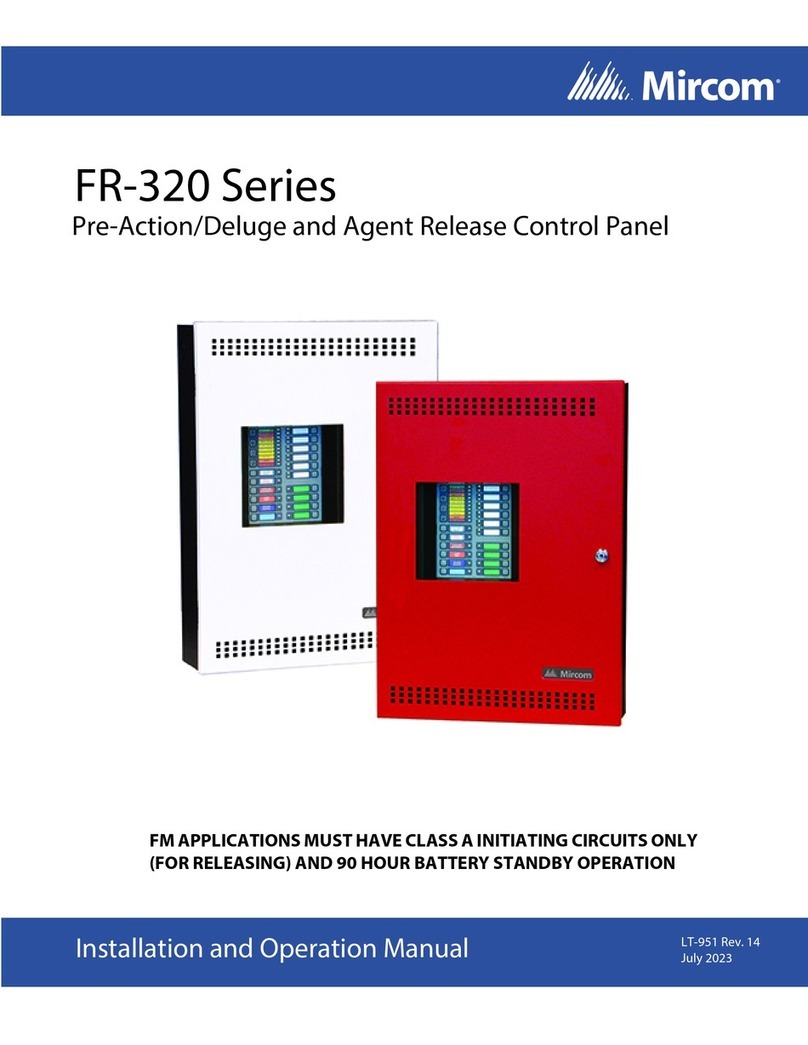
Mircom
Mircom FR-320 Series Installation and operation manual
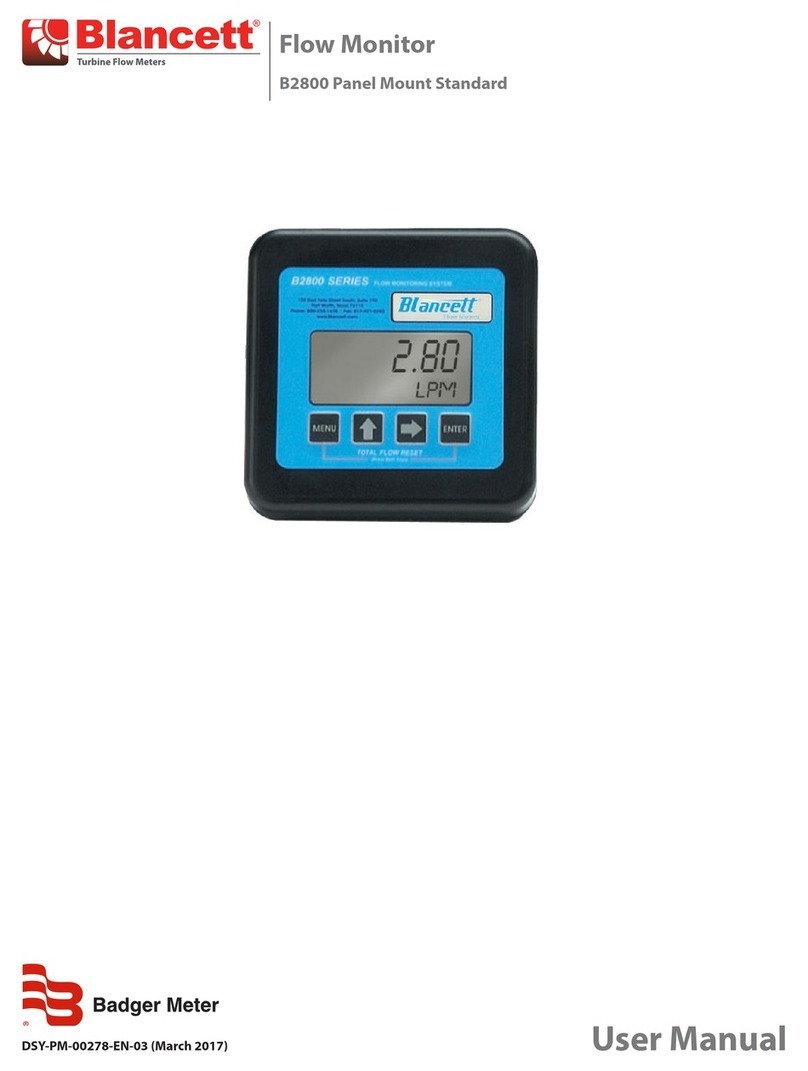
Blancett
Blancett B2800 SERIES user manual
Vicon
Vicon V1400X-DVC-3 instruction manual
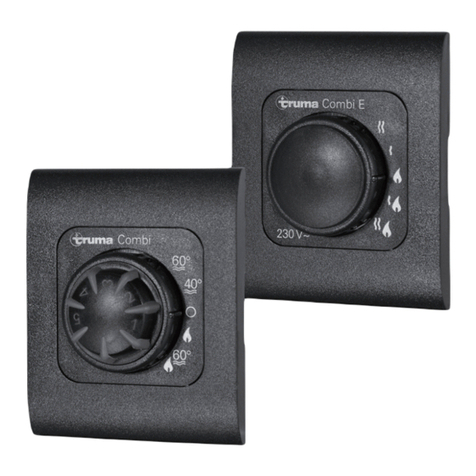
Truma
Truma CP E classic Operating instructions & installation instructions
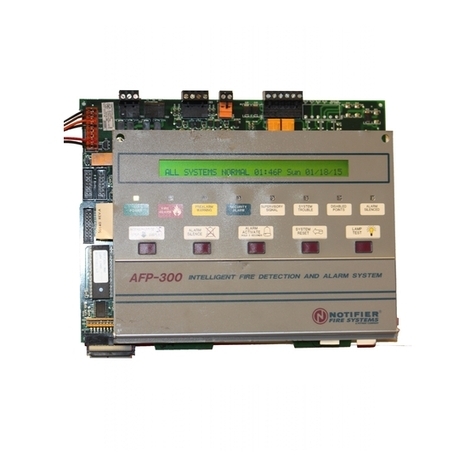
Notifier
Notifier AFP-300 installation manual
